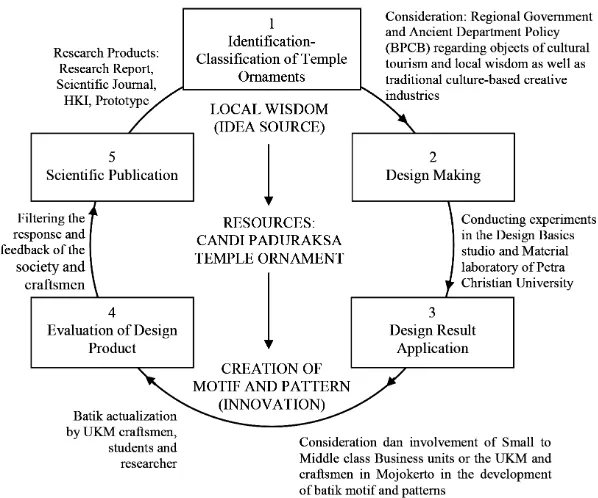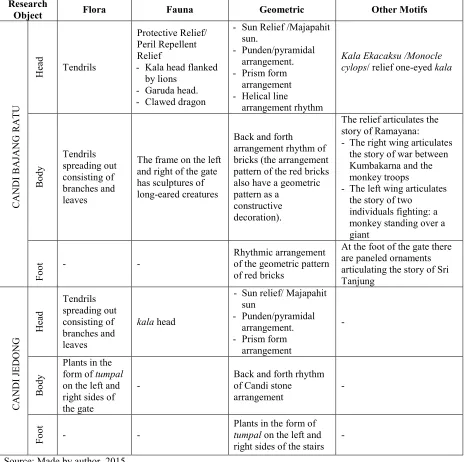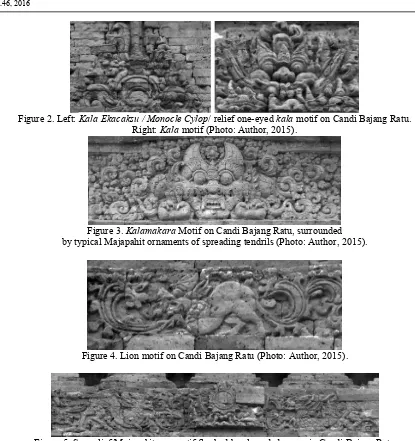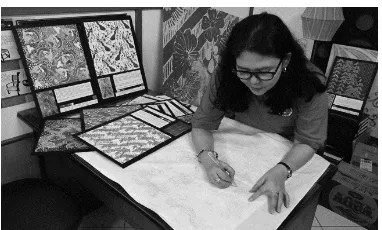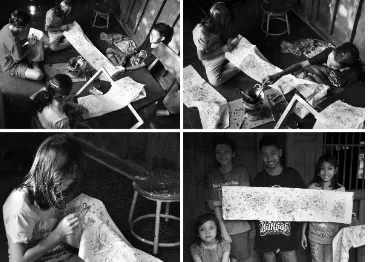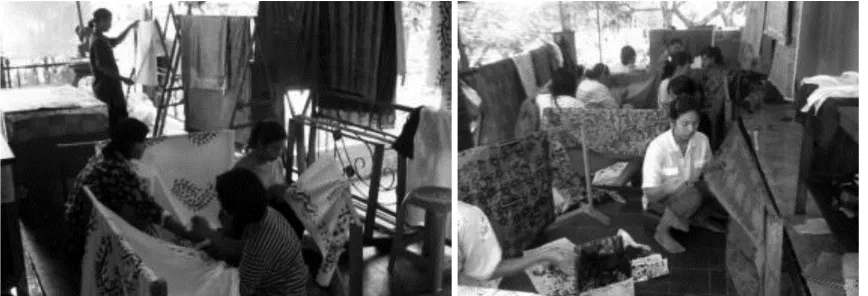Implementation of Paduraksa Temple Ornament for Batik Motif
Development
Laksmi K.Wardani* Ronald H.I. Sitinjak Sriti Mayang Sari
Interior Design Department, Faculty of Art and Design, Petra Christian University, Indonesia
The research that forms the basis of this article was funded by Ministry of Research, Technology and Higher
Art product components in the form of ornaments function as decorations that add aesthetic value to the building. They are aesthetic expressions produced with specific spiritual as well as material objectives that contain symbolic values related to the artist’s life views and beliefs. Temple ornaments contain various knowledge and clues that could be used to trace the cultures of the past. Moreover, they could also be used to stimulate new applicative ideas and development of creativity in other fields of art such as batik motifs, which will be the objective of this research, taking the Paduraksa temple ornament as the resource. It is hoped that through this research, the valuable art of heritage temple ornaments could be revived, communicated and adapted to the needs of the contemporary society. Other advantages that can be drawn from this research are the stimulation of design developments on the basis of local wisdom and the increase of economic value in local creative industries.
Batik is a national art that has been universally accepted as an Indonesian heritage artefact and will continue to thrive with new innovations, although there would be some maintained continuations. Without diminishing the significant meanings contained in the ornaments, the focus of this research is to conduct experiments on batik motifs developing from the ornaments on Candi Paduraksa. Motifs and patterns play significant roles in the process of batik making. With various alternative materials as the media of application, the design results would not be limited to fashion motifs but also those that could be used for interior design fabrics and other elements.
Education, Republic of Indonesia. Abstract
The gate of Candi Paduraksa or the Paduraksa Temple is a historical artefact that possesses historical, art, cultural and religious values. It contains sources of knowledge and experience in the art of building decoration. In this study, the various ornaments carved on the building in the past have been chosen as the resources for developing new ideas of Batik motifs and patterns. Using the descriptive analytical method of approach, this research aims to identify the unique characteristics of the Paduraksa Temple ornament as sources of knowledge as well as inspiration and to perform experimental studies in order to develop new Batik motifs and patterns from those sources. The new Batik motifs and patterns developed from this research provides opportunities in increasing creative economy of small to medium business units. Developing the arrangement pattern of Batik motifs would not only consider aesthetic values but also examine the skills and capacity of local craftsmen in the production process.
Keywords: workforce sizing, job-shop production, holonic model
1. Introduction
2. Research Method
The research steps discussed above have been summarized in the following diagram:
Figure 1. Research Steps (made by author, 2015)
This research is an experimental research, using the descriptive method of analysis to describe the aesthetic values of the ornaments on Candi Paduraksa. Data were collected through various methods such as (1) Literature studies, in order to find data and information regarding the various ornaments on Candi Paduraksa in Mojokerto East Java (2) Visual documentation and field observations of Candi Paduraksa and UKM (small to medium business units) industries in order to draw out the positive potentials of Mojokerto local art and craft, and (3) Interview with batik makers, craftsmen and experts. The data were grouped and classified in order to anticipate the realization of new motif developments that could be applied as batik motifs. The next step was to make some design alternatives in the form of idea sketches which were then criticized in terms of aesthetic value particularly in consideration to the forms and pattern arrangements. Entering the step of design development, the initial designs were then developed to find the best composition that would then be actualized into a prototype which would eventually be evaluated again for further improvement.
3. Result and Discussion
3. 1. Identification of Candi Paduraksa Temple Ornament
Temple architecture is a historical evidence that the past Indonesian society understood their main sources of knowledge from their religion and other external cultural elements that existed in compliance with the cultures and beliefs (values, norms and faith) of their original society. Ornaments can be a reflection of the attempt to enrich objects with values triggered by aesthetic and spiritual demands. Building ornaments often contain symbolic meanings and other values relating to life philosophies of their creator and the society he lives in (Guntur, 2001). This understanding explains that ornaments do not only function as building decoration but also represent sacred values. Theoretically, ornaments could be categorized according to their means into sacred or secular functions. Sacred functions include magical and symbolic means, whereas secular functions imply profane character in which the ornaments function as aesthetic or artistic elements (Gustami, 2008).
Table 1. The ornaments on the relief of Candi Paduraksa in Mojokerto Research
Object Flora Fauna Geometric Other Motifs
Figure 2. Left: Kala Ekacaksu / Monocle Cylop/ relief one-eyed kala motif on Candi Bajang Ratu. Right: Kala motif (Photo: Author, 2015).
Figure 3. Kalamakara Motif on Candi Bajang Ratu, surrounded by typical Majapahit ornaments of spreading tendrils (Photo: Author, 2015).
Figure 4. Lion motif on Candi Bajang Ratu (Photo: Author, 2015).
Figure 5. Sun relief/Majapahit sun motif flanked by clawed-dragons in Candi Bajang Ratu (Photo: Author, 2015).
3.2. Design and Batik Making Process
Developing batik design requires much creativity and this could be seen in the design process and the product of the batik motif arrangement. Design experiments started with the selection of motifs as the source of idea and development, followed by novel creations of motifs through freehand sketches and then continued by the organization or arrangement of motifs into a pattern and composition using computer tools as the media. The patterns were then experimented on Mori Primisima cloth with the traditional technique of mbatik (drawing batik motifs on a cloth through wax-resist dyeing using a spouted tool called canting).
Figure 7. Pattern making process on the Mori Primisima cloth (Photo: Author, 2015).
Generally, a batik pattern consists of three main elements: klowongan, isen-isen and pengisi. Klowongan is the primary ornament or pattern, isen-isen or isen is the content pattern of the primary ornament (klowongan) while pengisi is the additional filling or background pattern that functions as a balance to the primary ornament in order to produce a harmonious combination (Doellah, 2002). An example of batik motif pattern and composition developed in this research is shown in the following figures:
Figure 8. The primary ornament (klowongan) forms the main batik pattern arrangement. This klowongan was inspired by the tendrils found on the candi (Designed by Wardani, 2015).
Figure 9. The primary ornament (klowongan) with secondary ornaments (isen) to fill in the primary parts (Designed by Wardani, 2015).
Figure 10. The primary motifs and patterns have been given additional patterns surrounding them (pengisi) that act as a background to balance the primary ornaments (Designed by Wardani, 2015).
There are three known techniques in the process of batik making: traditional, kesikan and pesisiran. In the experiments conducted in this research, the technique used was pesisiran. However, the author find it necessary to provide a prior explanation of the both the traditional as well as the kesikan process in order to understand the whole concept of batik making.
The traditional process of batik making is the process used in the making of traditional batik using the colours indigo and soha with the following stages: mbatik (making patterns on mori/cloth by sticking batik wax using canthing tulis or the writing canting), nembok (closing the parts of the pattern that would be left white with the batik wax, medel (soaking the mori or cloth that has been given batik wax into the blue coloured pigments), ngerok and nggirah (getting rid of the wax from the parts that would be given brown or soga colour), mbironi (covering the parts that would still be given blue colour and the parts that have cecek or dotted patterns), nyoga (soaking the cloth in a soga solution), and nglorod (getting rid of the batik wax with boiling water). The nglorod would be the final stage of the traditional process of batik making (Doellah, 2002).
Kesikan is one of the batik process where the stage of getting rid of the batik wax before soaking in the brown or soga pigment solution is done by getting rid of the wax attached to the cloth with boiling water. Kesikan is also termed lorodan. The sequence of batik processing in this case is similar to the traditional batik making: mbatik, nembok, medel, nglorod (getting rid of the wax on the cloth becomes kelengan), ngesik (covering the parts where blue colour is maintained as well as the parts where white and cecek or the dotted pattern is maintained), nyoga, and nglorod (Doellah, 2002).
The mbatik pesisiran process was used in the experiment of this research consisting of: mbatik (making patterns on the mori or cloth by applying batik wax using canting tulis), nyolet (giving colour to certain parts by dabbing coloured pigment solutions on those parts), nutup (covering the parts that have been dabbed with batik wax), ndhasari (soaking the background pattern with desired coloured pigments), covering of the dasaran (covering the areas of the background pattern that has already been coloured), medel (soaking in blue colour), nglorod (getting rid of all the wax on the mori or cloth in a tub of boiling water and yielding coloured kelengan), nutup and granitan (covering the areas that has been coloured and the parts that would be left white as well as making white dots on the lines outside the outer pattern known as granit with batik wax), nyoga (soaking in brown or soga pigment solution), nglorod (getting rid of all the wax with boiling) (Doellah, 2002).
Figure 11. Practice in making mbatik klowongan patterns with primary 5 and 6 school children in the researcher’s home. The technique of batik making needs to be introduced to the young generation from childhood. The skills of batik making are passed down through demonstrations and verbal explanations. The study process was developed through looking, observing and direct practicing on site (Photo: Author, 2015).
3.3. Small to Medium Business Unit (UKM) of Batik Makers in Mojokerto
with batik makers and craftsmen in Mojokerto, the same city where Candi Bajang Ratu and Candi Jedong, the objects of this research, are located. This is useful for developing possible batik motifs and patterns that suit the taste of their people.
As a part of the economic activities of Mojokerto, batik making is considered belonging to the category of small to medium business unit known as Usaha Kecil Menegah (UKM). However, the government agencies have attempted to hold many activities so as to increase the design creations of local artists and craftsmen. In July 2010, during the batik exhibition in memorial of the national Union Day in Gresik, the batik tulis of Mojokerto was awarded the first winner (Guntur, Suratno, Marwati, and Sugihartono, 2013). The local government of Mojokerto has determined the orange-coloured motif called Rengkik as its trademark batik that should be worn as their workers’ civil outfit.
Some batik makers who were observed and interviewed by the author are batik makers Heni Yunina who owns a workshop in Dinoyo-Jetis-Mojokerto and an art shop in Gajahmada street No. 05 Mojosari – Mojokerto, batik maker Sofia in Mojopahit-Suratan street Gang Tengah No. 15 Mojokerto, batik maker H. Ali Kasyan in Suratan Gang 4 Desa Kranggan Mojokerto, and batik maker Erna in Surodinawan street II no. 26, Prajurit Kulon district, Mojokerto. These batik makers of Mojokerto have been successful in producing batik tulis and also have many batik cap (stamped batik). However, though interview, it has been found that batik maker Sofia was not yet successful in penetrating the export market and was only known in the local East Java market around Malang and Mojokerto city, despite having been awarded the best design category in the East Java regional Deskranasda exhibition. This indicates that there is a need to increase the design quality, market taste studies, information technology and marketing strategies.
Figure 12. Researchers assessing the batik products of UKM Sofia in Mojokerto. Sofia is one of the batik makers who had been awarded the best design category in the East Java regional Deskranasda exhibition (Photo: Author, 2015).
Figure 13. The process of batik making by UKM batik maker Heni Yunina. Generally, batik tulis (writing batik) is done by female batik while batik cap (stamped batik) is done by male (Photo: Budiono, 2012).
4. Conclusion
The ornaments on Candi Paduraksa contain knowledge and experiences in the art of building decoration of the past. The beauty of these ornaments are not only seen in their visual form but also in their pattern arrangements and compositions. The various ornaments discovered became the material idea for developing batik motif designs. Various batik motifs could be found and developed from Candi Paduraksa such as the Majapahit sun,
Kala Ekacaksu/ Monocle Cylop, tumpal, tendrils or lung-lungan, flowers and magic creatures. The complexity
orderly and unified rhythmic arrangement. Arranging the patterns of batik would not only mean to pay attention to the aesthetic beauty of the composition but also the society’s taste. Creativity in the design development could be seen from both the process and result of the batik makers in Mojokerto that ought to be passed down and continued to the younger generation.
References
Budiono, Rendi. (2012). “Batik Khas Majapahit NEGI Batik”, accesed Desember 15, 2015, http://mojokerto.blog.com/2012/06/01/batik-khas-majapahit-negi-batik/
Doellah, Santosa H. (2002). Batik Pengaruh Zaman dan Lingkungan. Surakarta: Danar Hadi. Guntur. (2001). Studi Ornamen. Surakarta: Sekolah Tinggi Seni Indonesia.
Guntur, Suratno, Sri Marwati, and Ranang A. Sugihartono. (2013). Kreasi Motif Batik Khas Mojokerto. Surakarta: ISI PRESS Surakarta.
Gustami, SP. (2008). Nukilan Seni Ornamen Indonesia. Yogyakarta: Jurusan Kriya Fakultas Seni Rupa Institut Seni Indonesia Yogyakarta.
